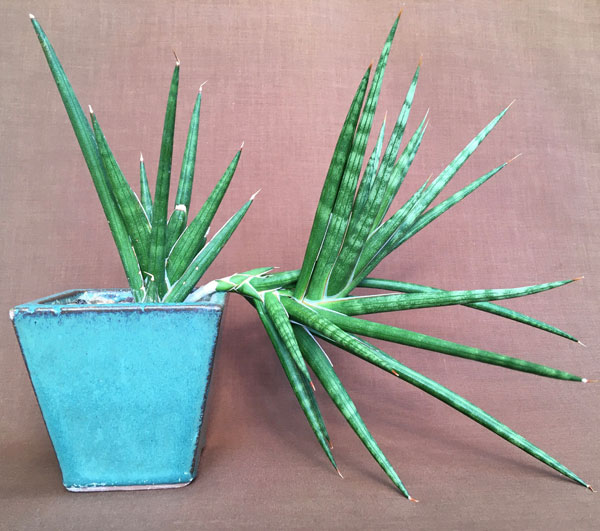Francis (Frank) Kenneth Horwood (1924–1987) was a doyen of succulent plant propagators. I visited him in 1970 when he was a technician at the University of Leeds Botanical Garden. He moved to California in 1975 where he worked at Lotusland and Abbey Garden Nursery. He visited Africa several times, notably Ethiopia, Kenya and Somalia (Glass & Foster, 1987). In 1982 Frank collected an unidentified Sansevieria at Garsen near the coast in Kenya which was distributed in cultivation under his collection number FKH 432. This was later named Sansevieria francisii Chahinian in his honour (Chahinian, 1995). Frank is also commemorated in the names of three other species: Dorstenia horwoodii, Euphorbia horwoodii and Pseudolithos horwoodii.
Sansevieria francisii is a relatively small-growing plant within the genus with stems only up to 30cm tall but usually shorter than this. It branches irregularly by sending out above-ground stolons up to 25cm long, so the plant can become untidy and flop over. Its leaves are up to 25cm long, arranged in five tiers, cylindrical, mainly circular in cross-section, tapering towards a sharp pointed tip and channelled at the base. These are dark green in colour and distinctly cross-branded in greyish green (Fig. 1). It needs to be grown in bright light conditions, otherwise the leaves elongate and turn a darker green (Chahinian, 2005).

Fig. 1 Young plant of Sansevieria francisii in a 10cm pot.
Fig. 1 Young plant of Sansevieria francisii in a 10cm pot.
In my experience S. francisii flowers freely even as a small plant, making it highly desirable in cultivation. Its inflorescence is unbranched up to 30cm tall, bearing flowers that are mottled dusky pink on the outside but ivory coloured internally and up to 3cm long (Figs. 2 and 3).
The flowers are densely arranged in groups of three or four. As with most sansevierias, the flowers are nocturnal, each flower opening late afternoon and closing the following morning. So although individual flowers only last a single night they open in clusters, resulting in a flower spike having flowers open for several days in succession. These presumably attract night flying moths as pollinators. As attractant they produce a heavy hyacinth-like scent which can pervade a living room at night but subsides by the following morning. Large numbers of droplets of extra-floral nectar (Fig. 3) are also produced as food for the insect pollinators.

Fig. 2 Flowering branch of Sansevieria francisii. Fig. 3 Close up of the flowers of Sansevieria francisii.
This species, like all sansevierias, is best grown as a house plant since it requires a minimum temperature of 10oC all year around but is best grown at 15oC or higher, so centrally heated living rooms are ideal for growing it.
Colin C. Walker
References
Chahinian, B.J. (1995) Sansevieria francisii, a new species from Kenya. Sansevieria J., 4: 12–14.
Chahinian, B.J. (2005) The Splendid Sansevieria. Privately published, Buenos Aires.
Glass, C. & Foster, R. (1987) Francis K. Horwood 1924–1987. Cact. Succ. J. (U.S.), 59: 91.
No part of this article may be reproduced without permission. Copyright BCSS & the Author 2020
